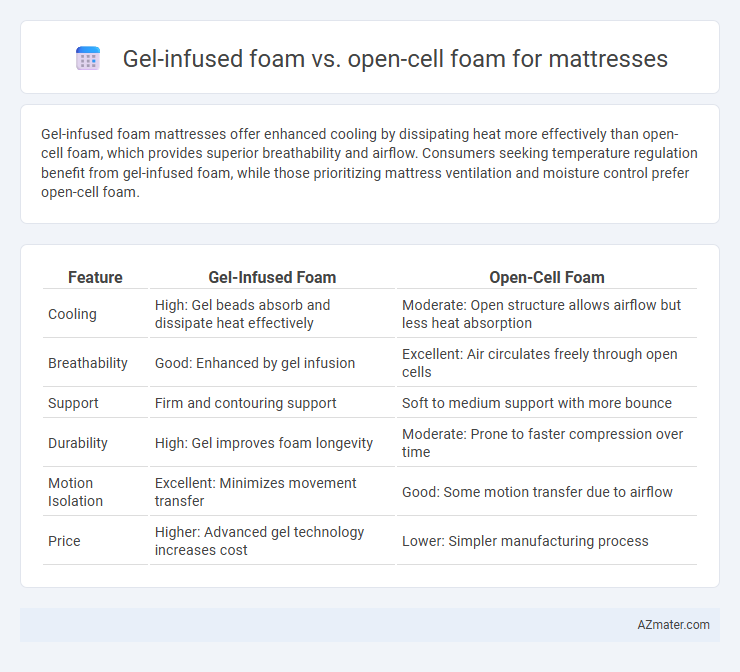Gel-infused foam mattresses offer enhanced cooling by dissipating heat more effectively than open-cell foam, which provides superior breathability and airflow. Consumers seeking temperature regulation benefit from gel-infused foam, while those prioritizing mattress ventilation and moisture control prefer open-cell foam.
Table of Comparison
| Feature | Gel-Infused Foam | Open-Cell Foam |
|---|---|---|
| Cooling | High: Gel beads absorb and dissipate heat effectively | Moderate: Open structure allows airflow but less heat absorption |
| Breathability | Good: Enhanced by gel infusion | Excellent: Air circulates freely through open cells |
| Support | Firm and contouring support | Soft to medium support with more bounce |
| Durability | High: Gel improves foam longevity | Moderate: Prone to faster compression over time |
| Motion Isolation | Excellent: Minimizes movement transfer | Good: Some motion transfer due to airflow |
| Price | Higher: Advanced gel technology increases cost | Lower: Simpler manufacturing process |
Introduction to Gel-Infused Foam and Open-Cell Foam
Gel-infused foam incorporates cooling gel beads designed to dissipate heat and enhance temperature regulation, making it ideal for sleepers who tend to overheat. Open-cell foam features a network of interconnected air pockets that promote airflow and improve breathability, contributing to a cooler sleep environment. Both materials offer pressure relief and contouring support, with gel-infused foam typically providing enhanced cooling properties compared to traditional open-cell foam.
Composition and Material Differences
Gel-infused foam incorporates cooling gel beads or liquid gel within the foam matrix, enhancing temperature regulation and heat dissipation compared to standard foam. Open-cell foam features a breathable structure with interconnected air pockets, promoting airflow and softness but typically lacks the heat-controlling properties of gel-infused foam. The key composition difference lies in gel integration versus pore structure design, affecting comfort, cooling, and durability in mattresses.
Temperature Regulation Abilities
Gel-infused foam enhances temperature regulation by incorporating cooling gel beads that absorb and dissipate body heat, preventing overheating during sleep. Open-cell foam promotes airflow through its porous structure, allowing heat to escape and maintaining a cooler sleeping surface. Comparing both, gel-infused foam excels in direct heat absorption, while open-cell foam provides superior breathability and ventilation for enhanced temperature control.
Breathability and Airflow
Gel-infused foam enhances breathability by incorporating gel beads that dissipate heat and improve airflow, reducing mattress temperature and promoting a cooler sleeping surface. Open-cell foam features a more porous structure that allows for superior air circulation, facilitating moisture evaporation and continuous ventilation throughout the mattress. Both materials significantly contribute to maintaining an optimal sleeping temperature, but open-cell foam typically offers greater airflow due to its naturally open network of air pockets.
Pressure Relief and Support
Gel-infused foam provides enhanced pressure relief by distributing body weight evenly and cooling heat-sensitive areas, making it ideal for hot sleepers or those with joint pain. Open-cell foam offers excellent support and breathability by allowing air to flow freely, reducing heat retention while contouring closely to the body. Both foams promote spinal alignment, but gel-infused foam excels in temperature regulation and pressure point alleviation compared to traditional open-cell foam.
Durability and Longevity
Gel-infused foam mattresses provide enhanced durability by maintaining their resilience and shape longer due to the gel's cooling properties, which reduce heat buildup and material degradation. Open-cell foam, while breathable and softer, tends to compress faster over time, leading to reduced longevity and potential sagging. Choosing gel-infused foam typically results in a mattress with a more stable lifespan and sustained comfort.
Motion Isolation Performance
Gel-infused foam mattresses excel in motion isolation by absorbing and dissipating movement effectively, reducing disturbance between sleeping partners. Open-cell foam provides decent motion isolation but can allow more motion transfer due to its breathable, less dense structure. Choosing gel-infused foam optimizes sleep quality by minimizing motion disruption for light sleepers or couples with varying sleep schedules.
Allergy and Health Considerations
Gel-infused foam mattresses offer enhanced hypoallergenic properties by resisting dust mites and reducing heat retention, which helps minimize allergy symptoms and promotes better sleep quality. Open-cell foam, with its breathable structure, improves airflow and moisture regulation, lowering the risk of mold and mildew buildup that can trigger respiratory issues. Both materials support allergy and health considerations, but gel-infused foam is often preferred for its cooling effects and increased allergen resistance.
Cost Comparison
Gel-infused foam mattresses typically cost more than open-cell foam due to advanced cooling technology and enhanced pressure relief properties. Open-cell foam mattresses are budget-friendly, offering good breathability and basic comfort at a lower price point. Consumers seeking affordable options often prefer open-cell foam, while those prioritizing temperature regulation may invest in gel-infused foam despite the higher cost.
Choosing the Best Foam for Your Sleep Needs
Gel-infused foam offers superior temperature regulation by dispersing heat, ideal for hot sleepers seeking a cooler mattress experience. Open-cell foam provides enhanced breathability and a softer, more responsive feel, benefiting those who prefer a plush and airy surface. Selecting the best foam depends on balancing temperature control and firmness preferences to optimize personalized sleep comfort.

Infographic: Gel-infused foam vs Open-cell foam for Mattress
 azmater.com
azmater.com